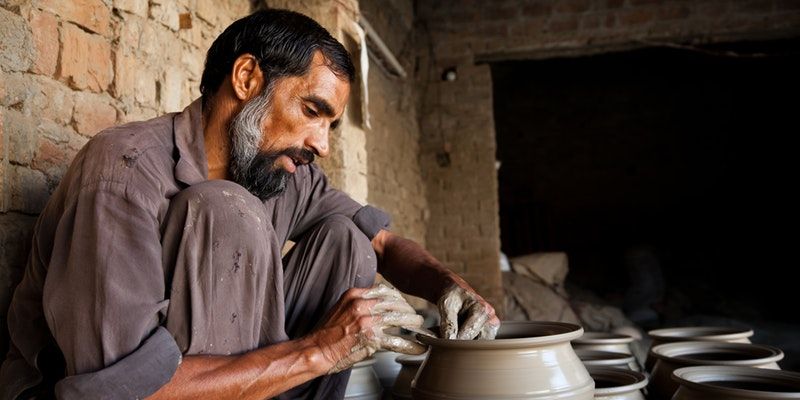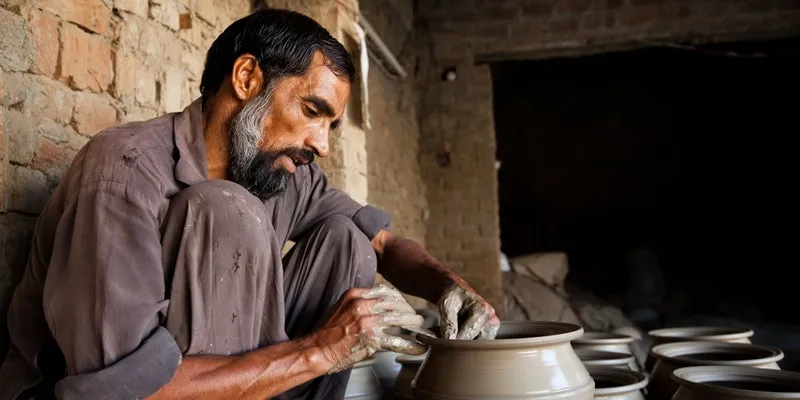4 schemes for empowering Indian handicrafts and artisans
To address challenges and develop the handicrafts sector, the National Handicraft Development Programme is being implemented by the Office of the Development Commissioner (Handicrafts). Here's how the four schemes work.
Palak Agarwal

Monday May 30, 2022 , 5 min Read
Handicrafts are an important part of the unorganised sector in India's economy. These usually require manual skills using simple tools and represent Indian tradition in some way or form. They have sustained lakhs of artisans in India through the years.
Handicrafts made through pottery, weaving, knitting, woodwork, etc have low energy and infrastructure requirements. According to an IMARC Group report, handicrafts are flourishing in India on account of the low capital investments. The sector is one of the largest employment generators in Indian and accounts for a significant share of the country's exports.
However, the on-ground reality paints a different picture: artisans face challenges such as inaccessibility of funds, low penetration of technology, absence of market intelligence, and poor institutional framework of artisan groups.
Over the years, a large number of artisans have moved to urban centres, seeking low-paying and unskilled employment.
To address these challenges and to develop and promote the sector, the government's National Handicraft Development Programme is being implemented by the Office of the Development Commissioner (Handicrafts). Presenting the Union Budget 2021, Finance Minister Nirmala Sitharaman also proposed the exemption on import of duty-free items as an incentive to exporters of handicraft items to give a boost to the sector.
1559140144500.jpg?fm=png&auto=format)
Image credit: Shutterstock
Here are four schemes for empowering Indian handicrafts and artisans.
Ambedkar Hastshilp Vikas Yojna
Under Dastkar Shashktikaran Yojna subsection of this scheme, the programme enables community empowerment to mobilise artisans into self-help groups. Post this, the implementing agency will prepare a diagnostic study report (DSR) for proposing further interventions in the cluster.
The implementing agency will be responsible for overall project management and implementation of various interventions to facilitate bulk production and sourcing of goods. Towards this end, apart from other things, the implementing agency will appoint a cluster manager.
Under the design and technology upgradation subsection, a 25-day workshop is conducted to develop new prototypes to suit the tastes and preferences of contemporary markets, using the traditional skill of artisans, and introduce new techniques and technologies for enhanced production.
Besides this, support is provided in the form of an integrated design and technology development project, assistance to exporters and entrepreneurs for design prototypes, and commercial market intelligence.
Ambedkar Hastshilp Vikas Yojna also provides support in human resource development, infrastructure and technology support, healthcare, and more.

Mega cluster scheme
The programme follows a mega cluster-based approach in scaling up infrastructural and production chains at handicraft centres that have remained unorganised and have not kept up with modernisation and other developments.
The objectives include generating employment and improving living standards for existing artisans.
The mega clusters will be taken up for development through the Handicrafts Mega Cluster Mission (HMCM) or through central/state corporations as and when announced in the Union Budget, or as per requirements, and as per the diagnostic report.
A maximum of three percent of the project cost shall be earmarked for establishing baseline data or reports against which performance can be compared at the end of the project. The total fund requirement will be as per the report. The maximum duration of the project is four years.
The report shall be considered and approved by the Project Approval and Monitoring Committee (PAMC). The PAMC shall accord further approvals only after the comprehensive reports are in place. The implementation of the various projects should also be reviewed periodically by the PAMC.
Marketing support and services scheme
This part of the programme provides interventions for domestic marketing events to artisans, such as providing financial assistance for organising or participating in marketing events in India. Assistance is also provided for hiring built-up space for events organised by other institutions. Besides this, craft awareness and demonstration programmes are also conducted.
Financial assistance is provided for organising or participating in marketing events abroad, market studies, craft exposure programmes, cultural exchange programmes, etc. There is also assistance provided for compliance, social, and welfare needs for artisans.
The marketing and support services component helps conduct domestic buyer-seller meets which provide linkages to local artisans to showcase their products to major buyers of India, thus ensuring integrated and inclusive development of Indian handicrafts. Buyer-seller meets, workshops seminars, etc are also occasionally organised abroad.
Another component is publicity and brand promotion, which highlights Indian handicrafts in print and electronic media, and on the web.
Research and development scheme
The schemes formulated are based on evaluation and research conducted from time to time by a governmental in-house research and development team. The initiative was introduced to generate feedback on economic, social, aesthetic, and promotional aspects of various crafts and artisans in the sector.
Surveys and studies are conducted on specific crafts on which enough information is not easily available, on problems related to the availability of raw materials, technology, and more.
Research is also conducted into measures to provide financial assistance for the preparation of legal, paralegal, standards, audits, and other documentation leading to labelling and certification for artisans' products, and more.
For more information on the National Handicraft Development Programme, click here.
Edited by Kanishk Singh






1551777893165.png?fm=png&auto=format&h=100&w=100&crop=entropy&fit=crop)




